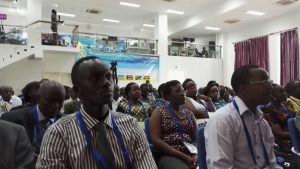The Antimicrobial agents’ usage, antimicrobial resistance and policy symposium
Multiple factors including the way antimicrobial agents are used in human medicine, agriculture and inability to implement medicines regulatory policies drive development and spread of antimicrobial resistance (AMR)1. The O’Neill Commission review warned that failure to act on AMR would result in an additional 10 million lives lost each year to drug-resistant strains of malaria, HIV, TB, and certain bacterial infections by 2050, at a cost to the world economy of 100 trillion USD1,2. On the 21st of Sept 2016, the UN general assembly acknowledged AMR as a global health threat and declared their commitment to fight it3,4. At this meeting, countries reaffirmed their commitment to develop national action plans on AMR, as stipulated in the Global Action Plan on Antimicrobial Resistance—the blueprint for tackling AMR5. In line with the action plan, countries are expected to investigate the magnitude of the problem, stop misuse of antimicrobial medicines, strengthen surveillance systems to monitor anti-microbial infections and the volume used in humans, animals and crops3.
The purpose of the symposium was to put these issues into the East African Community perspective and draw points for AMR action plan for the region. The main goal of the symposium was to highlight what the EAC member States should do to prevent further emergence antimicrobial resistance, manage antimicrobial resistant infections while preventing their spread. Hosted as part of the 6th East African Health and Scientific Research Conference and International trade fair, the symposium was divided into two sessions: expert presentations to highlight the challenges and stimulate discussion and then panel discussion to put pertinent issues into perspective. The following topics were addressed:
- The Global action plan on AMR: what implementation lessons can be drawn by the EAC?
- Situation analysis of the use or misuse of antimicrobial agents in EAC in relation to the rest of Africa.
- The magnitude, transmission dynamics, and drivers (biological, health system, socio-economic etc) of antimicrobial resistance in EAC.
- The human – animal (and agricultural) interface impact on the use of antimicrobial agents and spread of antimicrobial resistance.
- Do EAC member states have policy and regulatory framework on the use of antimicrobial agents – to what extent are these policies being practiced?
- To what extent is research evidence being used in formulating policy on use of antimicrobial agents?
- Situational analysis of the capacity (laboratory, clinical, community health etc) of health systems among EAC states to prevent or manage antimicrobial resistance
- National antimicrobial resistance task forces – challenges and opportunities in addressing the use or misuse of antimicrobial agents.
TWENDE consortium sponsored the symposium co-chaired by Dr. Wilber Sabiiti of the University of St. Andrews and Dr. Helen Meme of Kenya Medical Research Institute (KEMRI). Dr. Sabiiti gave a prologue to the symposium bringing into context the World Health Organisations’ global action plan on antimicrobial resistance and implementation lessons for the EAC. Dr. John Ndemi Kiiru of KEMRI brought to the fore the situation analysis of AMR in East Africa highlighting the magnitude and drivers of AMR in the region. Dr. Kiiru further noted the importance of urbanisation along main transport networks as hotspots for AMR emergence and spread. Associate Professor Benon Asiimwe of Makerere University addressed the AMR challenge at the human-animal interface. He noted that the pastoralist communities in E. Africa have been neglected by the health system and thus resorted to self-medication sharing antibiotics with their livestock. These antimicrobials are most often sold in open markets under the trees in grazing fields. The panellists who included representatives of the Medicines regulatory bodies and AMR task forces in the EAC member states put into context the AMR challenges and the antimicrobial agents’ usage policy in the EAC. It was important to note that the problem wasn’t the absence of antimicrobial agents’ regulations but ineffective implementation of these exiting regulations. Mr. Fred Orina and Ms. Barbara Miheso of KEMRI gave the TWENDE perspective of translation of research into policy and practice as crucial for improving effectiveness of policy implementation and keeping research institutions relevant to healthcare delivery in the region.
The symposium took place on 31st March 2017 at Ecole technique professionnelle de bujumbura, Burundi. Over 200 delegates: students, academics, healthcare professionals, policy makers, diplomats, business men & women, animal health practitioners, pharmaceutical industry professionals attended the symposium representing a broad spectrum of views from society. Practical recommendations came out of expert presentations, panel discussion and the audience and will be compiled into policy recommendation compact. The compact will be submitted to the East African Health Research Commission who will translate it into the EAC policy on antimicrobial agents and antimicrobial resistance policy and action plan.


References
- The Review on antimicrobial resistance, chaired by Jim O’Neill. Securing New Drugs for Future Generations: the Pipeline of Antibiotics. London; 2015:1-44.
- The Review on antimicrobial resistance, chaired by Jim O’Neill. Antimicrobial Resistance: Tackling a Crisis for the Health and Wealth of Nations. 2014:1-20.
- General Assembly of the United Nations. PRESS RELEASE: High-Level Meeting on Antimicrobial Resistance. September 21st 2016:1-5.
- General Assembly of the United Nations. Draft Political Declaration of the High-Level Meeting of the General Assembly on Antimicrobial Resistance. New York; 2016:1-5.
- World Health Organisation. Global Action Plan on Antimicrobial Resistance. Geneva; 2015:1-28.